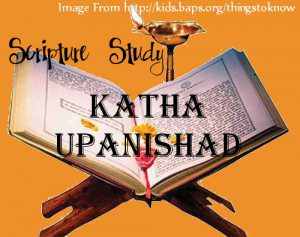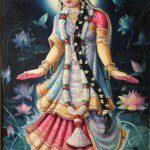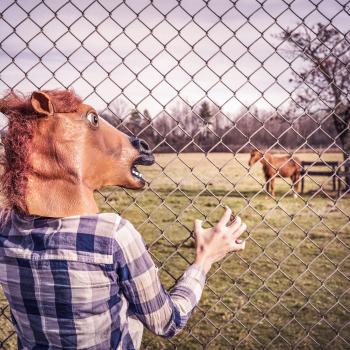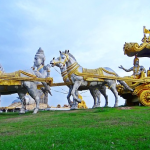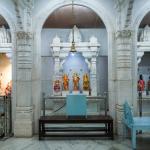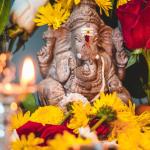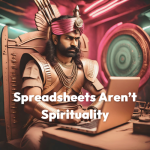We are doing a scripture study together: reading along through some scriptures and discussing the passages. We are reading one of my favorite upanishads: The Katha. This is the story of a boy who chatted with the God of death.
http://www.angelfire.com/electronic/awakening101/upani_katha.html
Chapter III
1
This is that eternal Asvattha Tree with its root above and branches below. That root, indeed, is called the Bright; That is Brahman and That alone is the Immortal. In That all worlds are contained and none can pass beyond. This, verily, is That.
2
Whatever there is—the whole universe—vibrates because it has gone forth from Brahman, which exists as its Ground. That Brahman is a great terror, like a poised thunderbolt. Those who know It become immortal.
3
From terror of Brahman, fire burns; from terror of It, the sun shines; from terror of It, Indra and Vayu and Death, the fifth, run.
4
If a man is able to realise Brahman here, before the falling asunder of his body, then he is liberated; if not, he is embodied again in the created worlds.
5
As in a mirror, so in the buddhi; as in a dream, so in the World of the Fathers; as in water, so Brahman is seen in the World of the Gandharvas; as in light and shade, so in the World of Brahma.
6
Having understood that the senses have their separate origin and that they are distinct from Atman and also that their rising and setting belong to them alone, a wise man grieves no more.
7
Beyond the senses is the mind, beyond the mind is the intellect, higher than the intellect is the Great Atman, higher than the Great Atman is the Unmanifest.
8
Beyond the Unmanifest is the Person, all—pervading and imperceptible. Having realised Him, the embodied self becomes liberated and attains Immortality.
9
His form is not an object of vision; no one beholds Him with the eye. One can know Him when He is revealed by the intellect free from doubt and by constant meditation. Those who know this become immortal.
http://www.vedarahasya.net/katha-6.htm
This banyan tree, which has got roots above the soil and branches underneath, is quite ancient. That (its root) is pure, that is Brahman, that is the eternal and immortal. On it rest all the worlds. No one goes beyond that. This is that (thing that we are contemplating about).
All these in the world arise from the Brahman, which is of the form of Praana or the life breath and revolves around it in discipline. It functions in clarity and discipline because of the great fear and awe about the strict rule of the Brahman, which is like the upraised vajraayuta – the acclaimed powerful weapon of Lord Indra. Whoever knows it to be so attains immortality.
From fear of it the fire burns; from fear of it the sun produces heat; from fear of it does Indra sends the rains and the wind blows; and it is because of the same that as the fifth, Lord Yama does his duty of snatching the lives of people.
If, before death, one is unable to understand the true Self, he is born again on the earth with a body (either as a plant or other stationary object or as a human based on the actions and thoughts he had during his life time).
The Atma can be seen, felt and understood like the reflection on a glass within everyone’s heart; like a dream in the world of the parents (pitru-loka); like the reflection on water in the world of the Devas (the Gandharva-loka) and like the light and shade in the world of God (the Brahma-loka).
Recognizing the distinct nature of each of the sense organs (which are unrelated to each other) from the Atma, the wise one who thinks about and understands the reason for the presence of such distinction during the state of awakening and the absence of such distinction during the state of sleep – he remains unaffected by sorrows.
Beyond the senses is the mind. Beyond it is the brain or intuition. Beyond that is the great soul (one of the aspects of the Atma). Beyond that great soul is the non-manifested or the invisible (or the Supreme Divine called as the avyakta).
Above that non-manifested is the Purusha (the all knowing and all pervading Atma). He is all pervading and is devoid of any particular mark or characteristic. On knowing Him to be so, the Jiva is liberated and attains immortality.
The form of the Purusha does not remain before the eyes. No one ever sees it with the eyes also. It can be seen only through a fully controlled mind and strong will power and intellect. Those who have known it to be so attain immortality.
Commentary (Swami Krishnananda)
The process of living can be compared to the growth of the tree. The reason why its roots strike upwards is the process of life itself.
…But, according to the Gita, God has no fancy. He takes the karmas of the jivas into consideration. Many trees grow on this earth: somewhere mango trees; somewhere thorns; various kinds in various places. The earth will bring forth whatever you sow, and sustain it, whether it is a tree with sweet fruit or a tree with bitter fruit. Likewise do the sun, the river, etc.; they shed light or give water to all in the same manner. Nature is absolutely impartial. So is God, the general Sustainer; He is supreme Impartiality, sustaining both the wicked and the virtuous.
…For example, we all go to sleep. A king sleeps, a beggar sleeps, a lawyer sleeps, and so on. We may say that in the state of deep sleep, we are all the same in one sense. The differences arise only when the ego sprouts. When it is hushed down in sleep, there is equality.
…Just as sleep is not samadhi, the being wound up after a kalpa is not liberation. When Brahma wakes up into consciousness in the next cycle, the jivas shoot forth, and as we awake, being what we were yesterday, after our nightly sleep, so do they wake up to work out their karmas. The manner of working them out may vary slightly from kalpa to kalpa, but the method or pattern is the same. And so, at every pralaya or cyclic dissolution, the seeds of jivas are in the tree of life. They are there; they are not created.
…The world and body, the panorama of creation, present before our senses a picture of permanency on account of the speed with which they rotate. If our eyes could rotate with the speed of the body’s electrons which form the bricks of the world, we could see them, and there would be no world to behold. They move fast and our eyes move slow, and hence there is perception of forms. There is destruction of body cells, a change in the position of electrons, and nothing remains steady. Like the flowing water of a river: when you touch it for a second, it is not the same as you touched earlier. Likewise, when you touch an object twice, you are not touching the same object. The flame of a lamp appears to be steady, but there is constant flow and you do not see the same flame a second time.
On Verse Four:
iha ced aśakad boddhum prāk śarīrasya visrasaḥ,
tataḥ sargeṣu lokeṣu śarīratvāya kalpate. (4)This is a highly controversial mantra, because the translation as it is seems to be incorrect. Shankara adds some words to give it a proper meaning, while Madhava changes the word ‘sarge’ into ‘svarge’.
Literally and grammatically translated it reads: “If a person is in a position to know this before casting off his body, he becomes fit for rebirth in some world.” This way, the latter part contradicts the earlier one, and because it does not make sense, Shankara says: “If one is not in a position to know… .” Max Mueller agrees in his translation. This is a possible meaning, but not suggested by the words. Other interpreters translate with: “If one has the strength to realise this truth before the shedding of this body, he becomes endowed with the power to enter into everything in the universe.” This seems to be correct, because it is corroborated through a mantra of the Chhandogya Upanishad which says that if one realises God he has free access to everything and nobody can restrict him. His freedom is unlimited like that of the gods, if only he reaches the goal before he sheds this body.
…As a face reflected in a mirror is not the original, so does the subject project its own psychic impurities onto the object and creates a tension of love and hatred between them. One does not become the other. One cannot become the other. But the characteristics of one get transferred to the other so much that you do not know which is the subject and which the object. Thus, in our world, there is a mix-up of the seer and the seen. This is samsara.
… The purusha without any mark cannot be meditated upon. So different Upanishads give us definitions and qualities of Him to be meditated on, like satyam, jnanam, anantam, vijnanam, tat tvam asi, etad vai tat, etc. These are symbols; not definitions of God. There are various symbols, including the idols in temples. Any one will do, provided it is taken as the final one. By this, the purusha can be realised.

